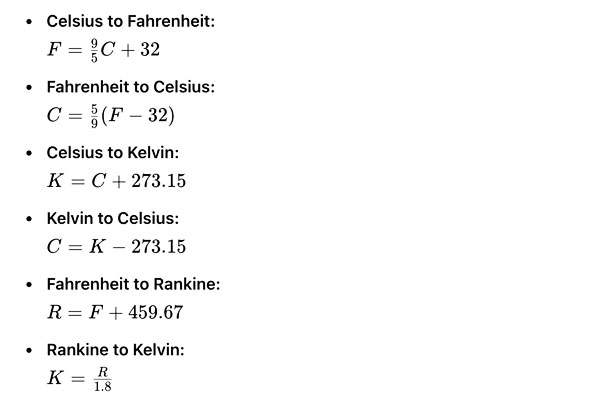Konverter suhu (℃ ⇄ ℉ ⇄ K)
Konverter suhu
Temperature conversion involves translating measurements from one temperature scale to another, such as Celsius to Fahrenheit or Kelvin to Rankine.
This process ensures consistency and clarity across different regions and industries that use various temperature scales.
Finishing permukaan, weather reporting, and scientific research all depend on accurate temperature measurements.
Our objective is to delve into the technical fundamentals, practical applications, and industrial significance of temperature conversion, illustrating its impact with data and real-world examples.
1. Understanding Temperature Scales
Different temperature scales serve various purposes in science, industri, and daily life:
- Celsius (° C.): Widely used in most countries and the scientific community; water freezes at 0°C and boils at 100°C.
- Fahrenheit (° f): Common in the United States; water freezes at 32°F and boils at 212°F.
- Kelvin (K): The absolute temperature scale used in physics and engineering; 0 K represents absolute zero.
- Rankine (°R): Similar to Kelvin but used in thermodynamic calculations, especially in engineering.
Tabel perbandingan: Key Temperature Scales
| Scale | Simbol | Freezing Point of Water | Boiling Point of Water | Absolute Zero |
|---|---|---|---|---|
| Celsius | ° C. | 0° C. | 100° C. | -273.15° C. |
| Fahrenheit | ° f | 32° f | 212° f | -459.67° f |
| Kelvin | K | 273.15 K | 373.15 K | 0 K |
| Rankine | °R | 491.67°R | 671.67°R | 0°R |
These scales form the basis for all temperature conversions, enabling engineers and scientists to communicate data accurately regardless of regional standards.
2. How Temperature Conversion Works
Temperature conversion relies on straightforward mathematical formulas that translate measurements between different scales. Here are some key formulas:

Contoh dunia nyata
Consider converting 25°C:

These conversions ensure that temperature data remains consistent, whether used in a laboratory experiment, an industrial process, or a weather forecast.
3. Types of Temperature Converters
Temperature converters come in various forms, each suited to different needs:
Manual Conversion:
Using mathematical formulas, ideal for educational purposes and quick calculations.Online Tools and Software:
Web-based converters provide instant results and are widely used by professionals, students, and hobbyists alike. They often integrate with other digital systems, ensuring seamless data flow.Mobile Applications:
Apps offer portable, on-the-go conversion capabilities, making them invaluable for travelers and field engineers.Physical Conversion Charts:
These are commonly found in industrial settings, laboratories, and manufacturing facilities where quick reference is needed.
4. Industrial and Scientific Applications
Engineering and Manufacturing
- Metallurgy and CNC Machining:
Precise temperature control is crucial for heat treatments and material processing. Misalnya, a temperature error of just 10°C can affect the microstructure of steel, altering its strength and durability. - Pemrosesan Kimia:
Accurate temperature measurements ensure that reactions occur under controlled conditions, which is essential for product quality and safety.
Medis dan perawatan kesehatan
- Fever Diagnosis:
Healthcare professionals rely on accurate temperature conversions to interpret patient data accurately, whether measured in Celsius or Fahrenheit. - Aplikasi Cryogenic:
In areas like organ preservation and cryosurgery, conversions to Kelvin are critical for ensuring optimal temperature conditions.
Industri Makanan dan Minuman
- Cooking and Baking:
Recipes and industrial ovens often require temperature adjustments between Fahrenheit and Celsius, ensuring consistent product quality. - Keamanan Pangan:
Regulatory standards often specify temperature ranges in specific units, making conversion essential for compliance.
Scientific Research and Space Exploration
- Laboratory Experiments:
Accurate temperature conversion is necessary for replicating experiments and maintaining consistency in research. - Spacecraft Thermal Control:
Di Aerospace, temperature measurements in Kelvin and Rankine are vital for designing thermal protection systems.
5. Emerging Technologies in Temperature Conversion
Recent advancements are enhancing the accuracy and efficiency of temperature conversion tools:
AI-Powered Prediction:
Machine learning algorithms now predict temperature trends and adjust conversion factors in real-time, especially useful in climate modeling and industrial processes.Integrasi IoT:
Smart sensors connected to cloud-based platforms provide real-time temperature data and automated conversions, leading to more responsive manufacturing and monitoring systems.Quantum Temperature Measurement:
Cutting-edge research in quantum metrology is pushing the limits of temperature measurement, crucial for experiments near absolute zero.
6. Kesimpulan
Temperature conversion is a cornerstone of scientific, industri, and everyday applications.
Whether converting Celsius to Fahrenheit for a weather report or Kelvin to Rankine for a spacecraft’s thermal control system, accurate temperature conversion ensures that data remains consistent and reliable.
By understanding the fundamentals of temperature scales, the mathematical principles behind conversion, and the various tools available, professionals can ensure precision in their work.
As emerging technologies such as AI and IoT further refine temperature conversion methods, we can expect even greater efficiency and accuracy in the future.
Intinya, temperature conversion is not just a mathematical exercise; it is a critical process that underpins many facets of modern technology and industry.
Embracing these advancements will help drive innovation and maintain high standards of quality across diverse fields.